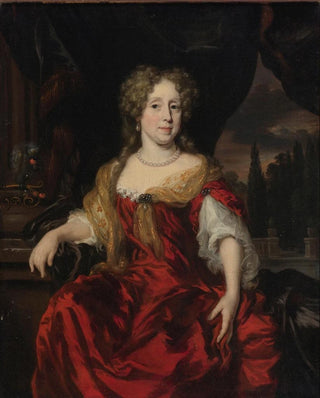Art print | Portrait of a lady wearing a red dress - Nicolaes Maes Source: Reproduction | Portrait d'une dame portant une robe rouge - Nicolaes Maes


View from behind

Frame (optional)
Captivating Introduction
The "Portrait of a Lady in a Red Dress" by Nicolaes Maes is a work that transcends the simple frame of painting to offer a fascinating glimpse into the life and customs of 17th-century Dutch society. This painting, rich in detail and emotion, captures the essence of an era when the portrait was much more than a mere representation: it was a means of communication and social status. Through this masterpiece, Maes invites us to immerse ourselves in a universe where beauty, fashion, and personality converge, creating an unforgettable visual experience.
Style and uniqueness of the work
The work stands out for its masterful use of color and light, essential elements in Maes's painting. The red dress of the lady, vibrant and striking, immediately draws the eye, while the delicate nuances of her complexion and the subtle reflections of light add depth to the painting. The composition is carefully balanced, with each element having its place, contributing to the overall harmony of the piece. Maes, as a master of chiaroscuro, skillfully plays with shadows and highlights to bring his subject to life, creating an atmosphere that is both intimate and captivating. This portrait is not limited to a simple physical representation; it evokes a presence, a personality that seems almost to animate before our eyes.
The artist and his influence
Nicolaes Maes, a pupil of Rembrandt, mastered his master's techniques while developing his own distinctive style. Active in Amsterdam, he captured the essence of bourgeois portraits of his time, blending realism and elegance. Maes depicted his subjects with such psychological depth that each portrait becomes a window into the soul of the person portrayed. His influence extends far beyond his era, inspiring many artists who followed. By incorporating elements of daily life into his works, he also contributed to the evolution of the portrait genre, transforming it into a tool of visual storytelling that continues to fascinate art lovers today.
An exceptional wall decoration signed Artem Legrand
The art print of

Matte finish

View from behind

Frame (optional)
Captivating Introduction
The "Portrait of a Lady in a Red Dress" by Nicolaes Maes is a work that transcends the simple frame of painting to offer a fascinating glimpse into the life and customs of 17th-century Dutch society. This painting, rich in detail and emotion, captures the essence of an era when the portrait was much more than a mere representation: it was a means of communication and social status. Through this masterpiece, Maes invites us to immerse ourselves in a universe where beauty, fashion, and personality converge, creating an unforgettable visual experience.
Style and uniqueness of the work
The work stands out for its masterful use of color and light, essential elements in Maes's painting. The red dress of the lady, vibrant and striking, immediately draws the eye, while the delicate nuances of her complexion and the subtle reflections of light add depth to the painting. The composition is carefully balanced, with each element having its place, contributing to the overall harmony of the piece. Maes, as a master of chiaroscuro, skillfully plays with shadows and highlights to bring his subject to life, creating an atmosphere that is both intimate and captivating. This portrait is not limited to a simple physical representation; it evokes a presence, a personality that seems almost to animate before our eyes.
The artist and his influence
Nicolaes Maes, a pupil of Rembrandt, mastered his master's techniques while developing his own distinctive style. Active in Amsterdam, he captured the essence of bourgeois portraits of his time, blending realism and elegance. Maes depicted his subjects with such psychological depth that each portrait becomes a window into the soul of the person portrayed. His influence extends far beyond his era, inspiring many artists who followed. By incorporating elements of daily life into his works, he also contributed to the evolution of the portrait genre, transforming it into a tool of visual storytelling that continues to fascinate art lovers today.
An exceptional wall decoration signed Artem Legrand
The art print of






